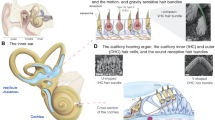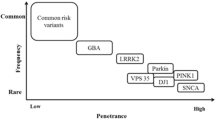Abstract
Background
Little is known about whether patients with complete congenital stationary night blindness (CSNB) maintain visual function throughout their lifetime. The purpose of this report was to describe clinical and genetic features of an elderly female patient with complete CSNB that we followed for 5 years.
Methods
Molecular genetic analysis using whole-exome sequencing (WES) was performed to detect disease-causing variants. We performed a comprehensive ophthalmic examination including full-field electroretinography (ERG).
Results
In the patient, WES identified two novel variants (c.1034delT; p.Phe345SerfsTer16 and c.1880T>A; p.Met627Lys) in the TRPM1 gene. Her unaffected daughter has one of the variants. The patient reported that her visual acuity has remained unchanged since elementary school. At the age of 68 years old, fundus and fundus autofluorescence imaging showed no remarkable findings except for mild myopic changes. Goldmann perimetry showed preserved visual fields with all V-4e, I-4e, I-3e and I-2e isopters. Optical coherence tomography demonstrated preserved retinal thickness and lamination. Rod ERG showed no response; bright-flash ERG showed an electronegative configuration with minimally reduced a-waves, and cone and 30-Hz flicker ERG showed minimally reduced responses. Overall, the ERG findings of ON bipolar pathway dysfunction were consistent with complete CSNB.
Conclusions
This is the oldest reported patient with complete CSNB and biallelic TRPM1 variants. Our ophthalmic findings suggest that some patients with TRPM1-related CSNB may exhibit preserved retinal function later in life.




Similar content being viewed by others
References
Schubert G, Bornschein H (1952) Analysis of the human electroretinogram. Ophthalmologica 123:396–413. https://doi.org/10.1159/000301211
Miyake Y, Yagasaki K, Horiguchi M, Kawase Y, Kanda T (1986) Congenital stationary night blindness with negative electroretinogram: a new classification. Arch Ophthalmol 104:1013–1020. https://doi.org/10.1001/archopht.1986.01050190071042
Bech-Hansen NT, Naylor MJ, Maybaum TA, Sparkes RL, Koop B, Birch DG et al (2000) Mutations in NYX, encoding the leucine-rich proteoglycan nyctalopin, cause X-linked complete congenital stationary night blindness. Nat Genet 26:319–323. https://doi.org/10.1038/81619
Pusch CM, Zeitz C, Brandau O, Pesch K, Achatz H, Feil S et al (2000) The complete form of X-linked congenital stationary night blindness is caused by mutations in a gene encoding a leucine-rich repeat protein. Nat Genet 26:324–327. https://doi.org/10.1038/81627
Dryja TP, McGee TL, Berson EL, Fishman GA, Sandberg MA, Alexander KR et al (2005) Night blindness and abnormal cone electroretinogram ON responses in patients with mutations in the GRM6 gene encoding mGluR6. Proc Natl Acad Sci USA 102:4884–4889. https://doi.org/10.1073/pnas.0501233102
Zeitz C, van Genderen M, Neidhardt J, Luhmann UF, Hoeben F, Forster U et al (2005) Mutations in GRM6 cause autosomal recessive congenital stationary night blindness with a distinctive scotopic 15-Hz flicker electroretinogram. Invest Ophthalmol Vis Sci 46:4328–4335. https://doi.org/10.1167/iovs.05-0526
Audo I, Kohl S, Leroy BP, Munier FL, Guillonneau X, Mohand-Said S et al (2009) TRPM1 is mutated in patients with autosomal-recessive complete congenital stationary night blindness. Am J Hum Genet 85:720–729. https://doi.org/10.1016/j.ajhg.2009.10.013
Li Z, Sergouniotis PI, Michaelides M, Mackay DS, Wright GA, Devery S et al (2009) Recessive mutations of the gene TRPM1 abrogate ON bipolar cell function and cause complete congenital stationary night blindness in humans. Am J Hum Genet 85:711–719. https://doi.org/10.1016/j.ajhg.2009.10.003
van Genderen MM, Bijveld MM, Claassen YB, Florijn RJ, Pearring JN, Meire FM et al (2009) Mutations in TRPM1 are a common cause of complete congenital stationary night blindness. Am J Hum Genet 85:730–736. https://doi.org/10.1016/j.ajhg.2009.10.012
Audo I, Bujakowska K, Orhan E, Poloschek CM, Defoort-Dhellemmes S, Drumare I et al (2012) Whole-exome sequencing identifies mutations in GPR179 leading to autosomal-recessive complete congenital stationary night blindness. Am J Hum Genet 90:321–330. https://doi.org/10.1016/j.ajhg.2011.12.007
Peachey NS, Ray TA, Florijn R, Rowe LB, Sjoerdsma T, Contreras-Alcantara S et al (2012) GPR179 is required for depolarizing bipolar cell function and is mutated in autosomal-recessive complete congenital stationary night blindness. Am J Hum Genet 90:331–339. https://doi.org/10.1016/j.ajhg.2011.12.006
Zeitz C, Jacobson SG, Hamel CP, Bujakowska K, Neuille M, Orhan E et al (2013) Whole-exome sequencing identifies LRIT3 mutations as a cause of autosomal-recessive complete congenital stationary night blindness. Am J Hum Genet 92:67–75. https://doi.org/10.1016/j.ajhg.2012.10.023
Furukawa T, Ueno A, Omori Y (2020) Molecular mechanisms underlying selective synapse formation of vertebrate retinal photoreceptor cells. Cell Mol Life Sci 77:1251–1266. https://doi.org/10.1007/s00018-019-03324-w
Nakamura M, Sanuki R, Yasuma TR, Onishi A, Nishiguchi KM, Koike C et al (2010) TRPM1 mutations are associated with the complete form of congenital stationary night blindness. Mol Vis 16:425–437
McCulloch DL, Marmor MF, Brigell MG, Hamilton R, Holder GE, Tzekov R et al (2015) ISCEV Standard for full-field clinical electroretinography (2015 update). Doc Ophthalmol 130:1–12. https://doi.org/10.1007/s10633-014-9473-7
Hayashi T, Hosono K, Kurata K, Katagiri S, Mizobuchi K, Ueno S et al (2020) Coexistence of GNAT1 and ABCA4 variants associated with Nougaret-type congenital stationary night blindness and childhood-onset cone-rod dystrophy. Doc Ophthalmol 140:147–157. https://doi.org/10.1007/s10633-019-09727-1
Ninomiya W, Mizobuchi K, Hayashi T, Okude S, Katagiri S, Kubo A et al (2020) Electroretinographic abnormalities associated with pregabalin: a case report. Doc Ophthalmol 140:279–287. https://doi.org/10.1007/s10633-019-09743-1
Katagiri S, Akahori M, Sergeev Y, Yoshitake K, Ikeo K, Furuno M et al (2014) Whole exome analysis identifies frequent CNGA1 mutations in Japanese population with autosomal recessive retinitis pigmentosa. PLoS ONE 9:e108721. https://doi.org/10.1371/journal.pone.0108721
Katagiri S, Hayashi T, Nakamura M, Mizobuchi K, Gekka T, Komori S et al (2020) RDH5-related fundus albipunctatus in a large Japanese cohort. Invest Ophthalmol Vis Sci 61:53. https://doi.org/10.1167/iovs.61.3.53
Mizobuchi K, Hayashi T, Yoshitake K, Fujinami K, Tachibana T, Tsunoda K et al (2020) Novel homozygous CLN3 missense variant in isolated retinal dystrophy: a case report and electron microscopic findings. Mol Genet Genomic Med. https://doi.org/10.1002/mgg3.1308
Guo J, She J, Zeng W, Chen Q, Bai XC, Jiang Y (2017) Structures of the calcium-activated, non-selective cation channel TRPM4. Nature 552:205–209. https://doi.org/10.1038/nature24997
Zeitz C, Robson AG, Audo I (2015) Congenital stationary night blindness: an analysis and update of genotype-phenotype correlations and pathogenic mechanisms. Prog Retin Eye Res 45:58–110. https://doi.org/10.1016/j.preteyeres.2014.09.001
Al-Hujaili H, Taskintuna I, Neuhaus C, Bergmann C, Schatz P (2019) Long-term follow-up of retinal function and structure in TRPM1-associated complete congenital stationary night blindness. Mol Vis 25:851–858
AlTalbishi A, Zelinger L, Zeitz C, Hendler K, Namburi P, Audo I et al (2019) TRPM1 mutations are the most common cause of autosomal recessive congenital stationary night blindness (CSNB) in the Palestinian and Israeli populations. Sci Rep 9:12047. https://doi.org/10.1038/s41598-019-46811-7
Milam AH, Saari JC, Jacobson SG, Lubinski WP, Feun LG, Alexander KR (1993) Autoantibodies against retinal bipolar cells in cutaneous melanoma-associated retinopathy. Invest Ophthalmol Vis Sci 34:91–100
Ueno S, Inooka D, Nakanishi A, Okado S, Yasuda S, Kominami T et al (2019) Clinical course of paraneoplastic retinopathy with anti-Trpm1 autoantibody in Japanese cohort. Retina 39:2410–2418. https://doi.org/10.1097/IAE.0000000000002329
Acknowledgements
The authors thank the patient and her daughter for participating in this study.
Funding
This work was supported by a grant from the Japanese Retinitis Pigmentosa Society (JRPS) Research Grant 2019.
Author information
Authors and Affiliations
Corresponding author
Ethics declarations
Conflict of interest
The authors declare that there is no conflict of interest.
Statements of human rights
All procedures performed in studies involving human participants were in accordance with the ethical standards of the institutional and/or national research committee and with the 1964 Declaration of Helsinki and its later amendments or comparable ethical standards.
Statement on the welfare of animals
This article does not contain any studies with animals performed by any of the authors.
Patient consent
The patient and her daughter have consented to the submission of the case report to the journal.
Informed consent
The protocol for this study was approved by the Institutional Review Board of the Jikei University School ofMedicine (approval numbers: 24-231 6997). The protocol adhered to the tenets of the Declaration of Helsinki, with written informed consent obtained from the female patient and her daughter.
Additional information
Publisher's Note
Springer Nature remains neutral with regard to jurisdictional claims in published maps and institutional affiliations.
Rights and permissions
About this article
Cite this article
Hayashi, T., Mizobuchi, K., Kikuchi, S. et al. Novel biallelic TRPM1 variants in an elderly patient with complete congenital stationary night blindness. Doc Ophthalmol 142, 265–273 (2021). https://doi.org/10.1007/s10633-020-09798-5
Received:
Accepted:
Published:
Issue Date:
DOI: https://doi.org/10.1007/s10633-020-09798-5




